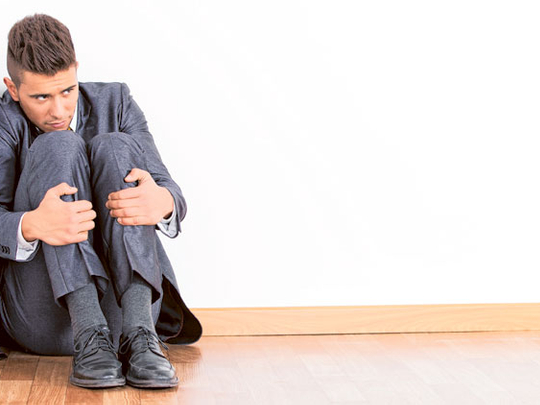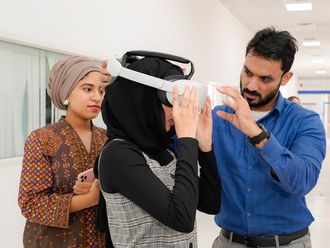
Dubai: Whether it’s the view from a high building, a tightly crowded space, or something as small as a spider that causes you to experience extreme fear, phobias are common disorders that may add unwelcomed distress to a person’s life.
But there is help. Clinical Psychologist Saliha Afridi and Managing Director at Lighthouse Arabia, Community Psychology Clinic describes a phobia as having irrational and excessive fear which results in the person avoiding the feared object, activity, or situation.
Despite some people underestimating the severity of people’s sudden reactions when stricken by fear, phobic disorders are considered a form of psychiatric illnesses.
“The reason why a person suffers from a phobia is biopsychosocial,” said Dr Afridi, adding phobias are concerned with biological, psychological and social aspects as appose to the strictly biomedical aspects of the condition.
Along with these aspects, “Neurobiological theories [mind and body dualism] show that people suffering from anxieties have lower serotonin levels and a higher level of activity in some parts of their brains than others,” she added, referring to those who suffer from phobias.
Dr Afridi further explained that psychosocial theories look at phobias from another angle.
“Psychosocial theories presume that a traumatic experience coupled with a lack of coping skills can trigger an excessive fear of the object or situation in the future for an individual.”
While this explains why a person can acquire a phobic disorder at any age, Dr Afridi said that typically phobias don’t start until after a child has formed a sense of self at age two.
Common phobias in the UAE
With the existence of hundreds of types of phobias affecting people around the world, several appear to be more common among people in the UAE.
According to the (DSM-IV-tr) The Diagnostic and Statistical Manual of Mental Disorders, some of the most usual phobias in the country lie under one of three forms. These forms are social anxieties, specific phobias, which include having excessive fear from specific animals, objects, and situations, and agoraphobia, a social phobia.
One form of phobic disorders is social anxiety. This mainly appears in a social situation where embarrassment can occur, said Dr Afridi.
Of specific phobias, a more popular form can include animal phobia, the fear from a specific animal such as dogs, cats, or spiders, as well as natural environment phobias, such as the fear from water, thunderstorms and sandstorms, explained Dr Afridi.
Anna Valeri, a university student from Armenia explained that her phobia from insects goes back to her childhood. “I used to have reoccurring nightmares about spiders, and now if I see any insect especially a spider, I start shivering, I get goose bumps and I close my eyes,” she said. Valeri added that she immediately has to leave the area, as it takes her a few minutes after an incident to calm down.
Other commonly seen specific phobias in the UAE also include blood-related phobias such as the fear of injury, injections, blood and accidents, as well as situational phobias, the fear of elevators and flying, said Dr Afridi. Under this form of disorders, claustrophobia, a fear from being in a closed area or small space, and acrophobia a fear of heights, are considered some of the more familiar situational phobias.
Another form of phobic disorders is agoraphobia. This disorder is another social type of disorder where a person experiences excessive fear of being in situations where they can’t escape from.
Steps to treating phobias
Many people suffering from phobias often wonder if there is a way to terminate the overpowering fear that appears to invade them. With the high success rates of treating phobias, Dr Afridi confirmed that getting rid of a phobia is in fact possible.
The treatment of phobias includes a high level of commitment and a lot of education about the specific condition. “Education about anxiety disorders and phobias is essential to a patient, and should be delivered to them and their supporting family members by their doctor,” she added.
Systematic desensitisation is another key point in the treatment of a phobia. The gradual exposure to the phobia while building and strengthening coping skills with each level of exposure is an affective method used with patients.
“This results in the person gaining confidence at every step as they are able to cope with the situations/places that eventually lead up to the them facing their phobia,” said Dr Afridi.
Using the fear of public speaking as an example, Dr Afridi explained that treating a person suffering from this phobia would begin with them having to conquer the material they are presenting on. “For the first presentation, the person would present to the doctor alone” she said. At the second presentation, a few family members would join as the audience, and finally the third presentation would also include a few strangers, she added.
One of the final stages of the treatment would require the person suffering from the phobia to present at an empty lecture hall or on a stage, followed by the very last step which is delivering the speech in a full auditorium.
“As we increase the person’s exposure to anxiety, we are also practising cognitive therapy [a psychotherapeutic approach that addresses dysfunctional emotions and maladaptive behaviours] to help them cope with anxiety,” Dr Afridi added.












